Hasegawa 1/48 F-86A Sabre
I did this Sabre back in 2003 and recently re-photographed it.
The Sabre almost didn't happen. Had the Air Force not been willing to delay the F-86 program while North American undertook to study the swept wing research done by Messerschmitt during World War II, the F-86 would have been a straight-winged airplane with a performance approximating the F-84 Thunderjet, and history would have been very different had that F-86 entered combat against the MiG-15 over Korea. Development of the Sabre was "just right," with its first flight in 1947 coming within months of the unknown Russian prototype it would meet a few years later, there were no major "bugs" to be worked out for production, and the airplane entered squadron service a year before the outbreak of the Korean War.
With the entry of the MiG-15 into combat over Korea in November 1950, it became imperative that the F-86 be sent to Korea since the MiG was vastly superior to everything else the Air Force had in-theater. The veteran Fourth Fighter Group was sent to Korea, and flew its first combat mission by the middle of the month. That December of 1950, the 4th Fighter Interceptor Wing - descendants of the American Eagles of the RAF and the top-scoring U.S. fighter group of World War II - arrived in-theater, equipped with the most advanced U.S. fighter, the superb North American F-86A "Sabre." The unit was not the "wing of aces" Korean War mythology would have you believe. Outside of squadron commanders and some flight leaders, the majority of the pilots were recent flight school graduates; three even got their "night flight rating" while crossing the US to San Diego for transport to Japan. As one of the leaders later said, "These young second lieutenants survived the crucible of combat because they were able to learn fast."
By the middle of December, it had been established that the Sabre could take on the MiG-15 with confidence both from equipment and flying ability of the pilot. The next two and a half years would see air battles between outnumbered Sabres and MiG-15s over "Mig Alley," which was basically the northeastern quarter of North Korea from just north of the capital at Pyongyang to the Yalu River.
There never was a "10:1 superiority" of the Sabre over the MiG-15. While the Sabres were superior to inexperienced Chinese and North Korean pilots, when the U.S. fighter went up against MiGs manned by Russians who were also veteran aces of the Second World War - as were some U.S. Sabre pilots - it was a different kettle of fish. The Russians of the 324th IAD (the first unit to enter combat) were commanded by no less that COL GEN Ivan Kozhedub, with 62 victories the Allied Ace of Aces of the Second World War; in fact, we now know that the Ace of Aces of the Korean War was not 16-victory ace Captain Joseph McConnell of the 51st FIW, but rather COL Yevgeny Pepelyaev, CO of the 196th Guards Fighter Regiment, a fierce believer in the adage "train hard, fight easy" who strove "to meet the American standard" with his pilots. During his 6-month tour in 1951, Peplyaev claimed 23 of the 104 victories scored by the 196th IAP. 1951 was known to US pilots as "the year of the honcho," and records examined since the fall of the Soviet Union and the end of the Cold War indicate that the 4th FIW and the 324th IAD each had about a 1:1 victory/loss ratio. Given pilots of equal abilities in airplanes of approximately equal performance, this is not surprising.
The F-86A and the MiG-15 were similar in performance, but quite different in details. The MiG excelled at high altitude combat, with a combat ceiling of 50,000 feet, while the Sabre's best combat altitude was below 35,000 feet, and it was wallowing to get over 40,000 feet. Thus, many combats began with the MiG-15 pilots deciding to attack with a dive on the Sabres below. Sergei Karamenko, a 13-victory MiG ace (on top of 12 WW2 victories), described combat between Sabres and MiGs thus: "The Sabre was the most dangerous threat to my friends and I in Korean skies. Our MiG-15 and the F-86 Sabre belonged in the same class, similar types with similar performance. They differed only in that the MiG had an advantage in rate of climb at altitude, while the Sabre was superior in maneuvering, especially at low level. These advantages could not always be used, however. The fight, as a rule, was decided in the first attack. After the first pass, we reached for altitude, while the Sabres rushed for the ground. Each tried to reach the altitude where it held a distinct advantage, and thus the battle faded."
Many World War II aces flew Sabres during the Korean War and added to their scores. One of these was Lt. Col. Glenn T. Eagleston, the top-scoring ace of the 354th "Pioneer Mustang" Fighter Group in the ETO, who added 3.5 victories during his tour with the 4th FIW in the Spring of 1951.
There is no model of the F-86A or F-86E in 1/48, manufacturers having decided to concentrate on the "definitive" Sabre (at least in USAF service), the F-86F series. The major difference between the early Sabres and the F-86F is that the latter aircraft has the "hard" 6-3 wing, an extended leading edge that does not have the slats of the early versions, which improved its high altitude capabilities against the MiG-15. Also, the F-86A did not have the "all flying" horizontal stabilizer that was the result of the X-1 program, which meant the airplane had difficulty penetrating "the sound barrier" in comparison with the later airplanes.
It is possible to mate the wings of the ProModeler F-86D to the fuselage of the Hasegawa F-86F, which I did back in 2001, but that is really quite a lot of effort due to the fact that ProModeler and Hasegawa differ on what is the correct wing sweep on the Sabre. An easier conversion is to use the F-86A conversion by Cutting Edge, which provides the wing leading edge with open slats, as well as the different rear fuselage associated with the A-model Sabre as compared with the F. The Scobie-Do Productions resin slatted early wing is an excellent no-hassle conversion if you can find it, since it is long out of production now (though you would have to make the modification to the rear fuselage yourself). Dave Lochead of Kiwi Aviation Resins has also done an F-86A conversion that should be still available and works for either Hasegawa or Academy Sabre kits.
In this case, construction started with the wing. Following the instructions in the conversion set, I cut off the leading edges of the Hasegawa kit's wings. This is accomplished by cutting along panel lines, which makes things very easy indeed. I had previously cut the resin leading edge off its molding block and cleaned it up. With the plastic wing parts glued together, the resin leading edge fit perfectly, and was attached with cyanoacrylate glue.
With that over, I turned to the fuselage. I cut the tail off the Hasegawa kit and attached the resin rear fuselage parts, which also fit without difficulty. I did discover when trying to glue the fuselage halves together that the backing around the dive brake wells was too thick to allow me to mount the exhaust pipe. This was easily solved by a few minutes' effort with the Dremel, grinding off the backing. The exhaust fit easily afterwards.
I had also decided to use a Jaguar resin cockpit with this kit. While the cockpit is for the F-86F, the differences between that and the F-86A cockpit are minimal - and even a Champion Picker of Nits would be unlikely to spot them. The big difference is that the cockpits of the early F-86As were painted grey, while the later production models had a black cockpit. I really like the Jaguar cockpit - the seat is excellent, with realistically-cast seat belts, and the rest of the cockpit is of equal quality. With this painted and installed, the intake trunking was attached and the fuselage was closed up. I also decided to close the canopy - it is very clear (and even more so if you Future it) and the airplane looks better closed up than with the canopy open. The Cutting Edge set provides a clear resin part for the angled windscreen of the early Sabres, which was also attached at this time after it too had been Futured. (It did however turn out that the particular airplane I did was one with the curved windscreen, an earlier version than this, but not one anyone has a conversion set out for) Because the F-86A does not have the 6-3 wing, you must sand off the area of the fuselage where the leading edge of the kit wing fits, and then rescribe the area. When I finally attached the wing to the fuselage, I used some C-A glue and Mister Surfacer 500 for gap-filling along the area where the upper surface of the wing fits to the fuselage.
At this point, the model was ready for painting.
I first painted the spar boxes of the wings with Gunze-Sangyo "Light Gull Grey," which is a good approximation of the color of the anodized metal used there. I also painted the tip of the rudder grey, and finished off by painting the nose cone with Tamiya "Red Brown", because the particular airplane I was doing had the intake cone left in the natural color of the fiberglass it was made of. (Many people have stated that Eagleston's airplane had a red nose, but Cutting Edge calls for the brown nose on their decal sheet.)
I then masked off these areas and painted the rest of the model with SnJ Aluminum, which I use as the base coat for multi-hue natural metal finishes, since it is impervious to masking tape when dry.
After the SnJ was dry, I masked off various areas of the fuselage and painted them with various hues of Testors ModelMaster Metalizer paints, which I sealed as I completed each different color.
Once all this was done, I removed the masking (which was done with drafting tape, NOT masking tape) and was ready for decals.
First, I attached the horizontal stabilizers and glued the dive brakes in the closed position - photos show that most F-86As sat in their revetments in this condition. I also attached the leading edge slats and the landing gear at this time so the model could sit on its gear while being decaled.
I used the Cutting Edge sheet "F-86A Sabres Part 3" (CED 48-175). I also used the Cutting Edge "Sabre Stencils" sheet (CED 48-028).
This Sabre has the early black-white stripes for identification that were later replaced by the more familiar yellow stripes. The decal sheet includes the black stripes, and assumes the modeler will airbrush the white areas. I elected to use white decal sheet, and applied that first. When it had set up, I applied the black stripes and allowed them to set up. Once this was done, I applied the rest of the decals. Cutting Edge decals are very thin, and go down well under a coat of Micro-Sol.
Once everything was set up, I washed off the dried decal solvent, dried the model, and gave it a light coat of Testors ModelMaster Sealer to protect the decals on the NMF surfaces.
I then attached the drop tanks. Drop tanks made at Misawa in Japan had a different separation trajectory than those made in the States, and if the pilot was not flying "unloaded" and straight and level when he punched the tanks off, they could somersault over the leading edge of the wing and damage the fuselage or the horizontal stabilizers. So that pilots were aware of which tanks they were carrying, Misawa tanks were painted Olive Drab, which I did for this model to make it look visually different from the other Sabres in my collection.
I now have at least one of the major sub-types of Sabre in my collection. It's too bad someone like ProModeler doesn't do an early Sabre, but till something like that happens, the
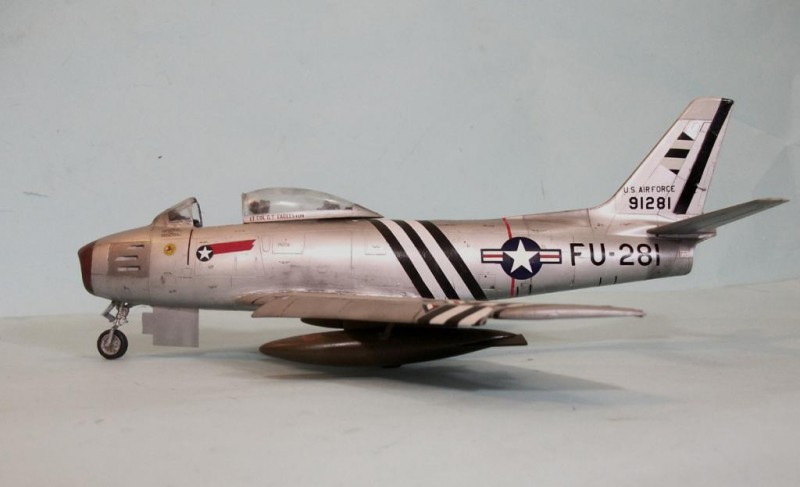
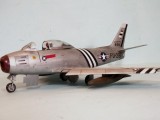
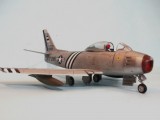
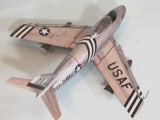
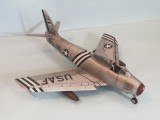
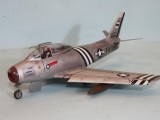
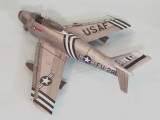
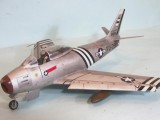
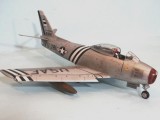
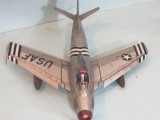
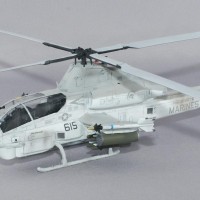
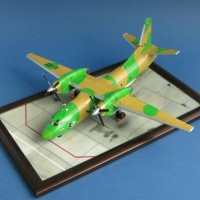
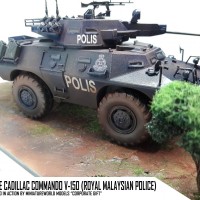

Now that was well worth the work and absolutley beautiful finish my friend. Love the overall finish 🙂
Judging from the length of the narrative, I have a pretty good idea who posted this one, too. However, I have my doubts, because I shouldn't be able to respond to it if I'm correct in my assumption. In any event, it's a good job on the model AND the photography.
Very nice looking Sabre. I like the use of the gull grey - I wouldn't have thought of that. Nicely finished - very realistic looking to me!
Great looking Sabre Tom! Very realistic finish, and I like the the use of the gull grey - I wouldn't have thought of that.
Nice first early SABRE ! first operative in combat
Like
🙂 ... Greetings ... 🙂 :
Nice looking SABRE, it is like a BLAST thru the PAST, she looks sharp.
Excellent realization ! This Sabre is in my projects.